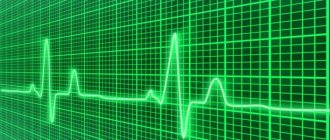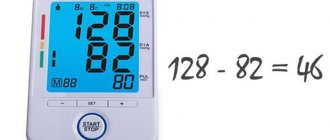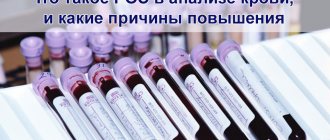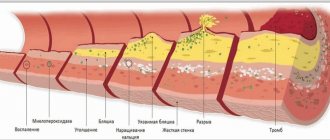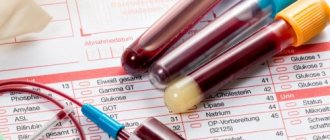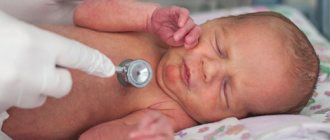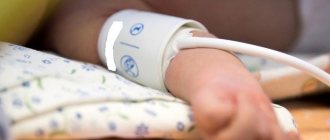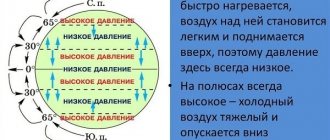Normal blood pressure in children
{banner_banstat0}
Normal blood pressure in children is very different from that in adults.
The values are influenced by the child’s age, which also determines the following parameters:
- the degree of elasticity of the walls of blood vessels;
- capillary mesh size;
- lumen in arteries and veins.
The younger the body, the better the condition of the circulatory system and the lower the blood pressure - blood moves freely through the vessels with minimal pressure on their walls.
The formation of blood pressure develops dynamically in the first 12 months after birth. During this period, it steadily increases by 1 mm Hg. Art. every 4 weeks. After a year the process of increase slows down.
Table “Normal blood pressure indicators in children under one year of age”
| Child's age | Reference blood pressure values (mmHg) | |
| Systolic | Diastolic | |
| First 2 weeks | 60–95 | 40–50 |
| 2 to 4 weeks | 80–110 | 40–73 |
| 4 to 8 weeks | 82–112 | 40–75 |
| From 8 weeks to 6 months | 85–115 | 50–70 |
| From 6 months to 1 year | 90–115 | 50–75 |
From birth to 5 years, the level of child pressure does not differ between girls and boys. From 6 to 9 years of age, blood pressure levels in males are slightly higher, and in adolescence they become slightly lower.
Table "Normal children's blood pressure by age"
{banner_banstat1}
| Number of years | Limit values of the norm (mm Hg. Art.) |
| From 1 to 2 years | 90–112/60–73 |
| From 2 to 4 years | 100–113/60–75 |
| From 4 to 6 years | 100–115/60–77 |
| From 6 to 8 years | 100–120/60–78 |
| From 8 to 10 years | 100–123/60–80 |
| From 10 to 12 years | 110–125/70–84 |
| From 12 to 16 years | 110–135/70–85 |
From 7 to 16 years the indicators gradually increase:
- in girls - by 1 mm Hg. Art.;
- in boys – by 1.5–2 mm Hg. Art.
Important! Due to the growth of the body, childhood activity and adolescence, large fluctuations in blood pressure are possible (20–25 mm Hg). If deviations greatly exceed acceptable limits, it is worth showing the child to a doctor.
Low blood pressure, or hypotension, occurs when blood pressure falls below the normal range. This occurs when the systolic (top) value falls below 90 mm Hg and the diastolic (bottom) value falls below 60 mm Hg. Art.
Blood pressure in children can decrease for several reasons. Identifying them will help parents normalize it.
Types of low blood pressure (hypotension) in children
The blood pressure threshold in adults is usually static, but in children it differs depending on age, height and other parameters.
Hypotension can be divided into several categories:
- Orthostatic hypotension : A child's blood pressure drops when he or she stands for long periods of time. Symptoms include headache, weakness, difficulty seeing.
- Neuromediated hypotension : Fainting that occurs when there is an abnormal reflex interaction between the brain and the heart due to a malfunction in the autonomic nervous system. This can happen when the child is in a warm room, stands for a long time, after exercise or after eating.
- Severe hypotension : a significant drop in blood pressure due to severe infection, severe blood loss, severe allergies, or injury.
Low blood pressure in children can be caused by various factors or may be the result of a condition or event.
Causes of low blood pressure in children
Some of the common causes that can lead to low blood pressure in children are:
- Dehydration . Low blood pressure may be one of several symptoms of mild to severe dehydration in children.
- Allergy . A severe allergic reaction (anaphylaxis) can cause low blood pressure.
- Infections . Hypotension may occur in cases of severe infection.
- Iron-deficiency anemia . Low blood pressure may be one of several symptoms of severe iron deficiency anemia in children.
- Heart problems . A drop in blood pressure may be a symptom of heart failure or other heart problems in children. Some other symptoms include breathing problems, excessive sweating and poor development.
- Bruise or injury . The bruise can lead to external or internal blood loss, which can cause a drop in blood pressure. Low blood pressure is often one of many symptoms of severe abdominal trauma that causes internal bleeding.
- Deficiencies of nutrients such as folic acid and vitamin B12 can cause hypotension.
- Problems in the endocrine system (the glands that secrete hormones) can also cause low blood pressure in children.
- Physical stress. Standing or sitting for long periods of time, sun exposure in the summer, intense exercise, and emotionally stressful events can also cause low blood pressure.
Signs and symptoms of low blood pressure in children
A child with low blood pressure is likely to have the following symptoms:
- dizziness or fainting;
- fatigue;
- nausea;
- difficulty concentrating;
- blurred vision;
- nausea;
- labored breathing.
Some people have mild symptoms (headaches and chronic fatigue), which may or may not indicate a drop in blood pressure.
Diagnosis of low blood pressure in children
To diagnose low blood pressure in children, the following procedures are performed:
- Assessing symptoms: The doctor will check for symptoms associated with low blood pressure and may ask parents about any health problems the child has.
- Auscultatory blood pressure measurement: The doctor uses a manual or digital sphygmomanometer to check the baby's blood pressure.
- Pulse detection: Fingers are placed on the artery to feel the pulse. This helps to know the number of heart beats per second.
- ECG: If any abnormalities are found, the doctor may suggest further examination of the heart using an ECG machine.
Treatment of low blood pressure in children
If your blood pressure has dropped due to any medical conditions such as heart problems, infections or allergies, then your doctor may prescribe medications for this.
Low blood pressure in children can often be managed at home when it is caused by physical stress, dehydration or poor diet.
Tips for caring for children with low blood pressure at home
To normalize low blood pressure in a child, follow these measures:
- Foods containing sodium (salty snacks, cured meats, cheese, chicken, soups, breads) may help maintain blood pressure.
- A well-balanced diet is also necessary to maintain blood pressure. The presence of vegetables, fruits and nuts in a child’s daily diet helps restore health. Foods rich in folic acid and vitamin B12 should be included in your regular diet.
- Drinking plenty of fluids helps prevent dehydration, which is one of the causes of low blood pressure in children.
- The child should avoid standing or sitting for too long, especially in a warm room.
- Compression stockings can help maintain optimal blood pressure in the upper body and prevent blood from pooling in the legs.
References:
- Low Blood Pressure in Children; Nicklaus Children's Hospital
- A. Banker, C. Bell, and J. Samuels; Blood pressure percentile charts to identify high or low blood pressure in children; BMC Pediatrics (2016)
- JM Stewart et al.; Pediatric Disorders of Orthostatic Intolerance; Pediatrics Official Journal Of The American Academy Of Pediatrics (2017)
- Patient Information Brochure On Neurally Mediated Hypotension And Its Treatment; Johns Hopkins Hospital (1995)
- M. Zaqqa and A. Massumi; Neurally Mediated Syncope; Texas Heart Institute Journal (2000)
- Low blood pressure; University of Florida Health
- Why is Dehydration so Dangerous?; Rehydration Project
- Food Allergies in Children; University of Rochester Medical Center
- J. Roganović and K. Starinac; Iron Deficiency Anemia in Children; Intech Open (2016)
- Heart Failure in Children and Adolescents; American Heart Association
- Recognizing Internal Injuries in Young Athletes; Stanford Children's Health
- Low Blood Pressure – When Blood Pressure Is Too Low; American Heart Association
- C. Corrado; Blood pressure measurement in children; Italian Journal of Pediatrics (2015)
- Low Blood Pressure: Your guide to symptoms, risk factors, treatment, recovery; Narayana Health
- Low Blood Pressure (Hypotension); Michigan Medicine
- Salt and Sodium; Harvard T.H. Chan
Causes of pressure deviations from the norm
{banner_banstat2}
Blood pressure disorders can be a physiological feature of the body or occur against the background of external stimuli or internal diseases.
Why does my child have high blood pressure?
External causes can affect blood pressure and temporarily increase its levels:
- injuries;
- emotional overstrain or severe stress;
- physical fatigue.
If a child's blood pressure is consistently higher than normal, this may be a sign of moderate hypertension.
The development of pathological processes in a young body can provoke sharp and regular jumps.
- Cardiac pathologies - anomalies in the valve structure, congenital defects, poor conductivity of the heart muscle, rhythm disturbances.
- Kidney diseases (cause an increase in diastolic pressure) - dysplasia, structural defects, malignant compactions in tissues, injuries.
- Endocrine problems. Crohn's disease or tumor processes in the parathyroid glands disrupt tissue metabolism, which leads to excessive production of hormones and biologically active substances that narrow the lumen in the blood vessels and cause hypertension.
- Changes in the renal vessels of a congenital or acquired nature. Pathologies provoke secondary hypertension and act mainly on upper (systolic) blood pressure.
- Hereditary tendency to high blood pressure. This happens when one of the parents suffers from hypertension.
High blood pressure can be the result of long-term drug treatment with hormonal drugs and sympathomimetics. Blood pressure in adolescents is affected by alcohol consumption or smoking.
Why does my child have low blood pressure?
{banner_banstat3}
As the body ages, the pressure gradually increases. If a child experiences frequent downward swings, we may be talking about the development of serious diseases.
Provoking factors for hypotension are:
- disturbances in the endocrine system, which lead to a decrease in venous tone and loss of vascular elasticity;
- problems in hematopoiesis, in particular anemia;
- deviations in normal blood circulation that are caused by injuries or seals in the brain;
- decrease in thyroid hormones (thyroid dysfunction), which weakens vascular tone.
Low blood pressure can be a consequence of improper or inadequate nutrition, physical and emotional fatigue. In this case, low levels are temporary and return to normal after eliminating external stimuli.
Orthostatic collapse in a teenager
Orthostatic collapse is a loss of consciousness immediately after assuming a vertical position of the body: if you stand up to your full height from a lying or even sitting position. If this happens in the morning, it is due to the vagal influence on vascular tone and heart rate, which is characteristic of the sleep state. In adolescents, fainting is also due to the physiological characteristics of age.
Why does a teenager faint?
Often, orthostatic collapse is the result of not just a sharp decrease in blood pressure, but a decrease in blood pressure to a critical level against the background of constant hypotension. During the period of active growth, many adolescents suffer from low blood pressure, since large vessels and the heart do not have time to grow as quickly as the skeleton and muscles. In this case, it is difficult to pump blood from the lower extremities to the head, as is keeping blood pressure constant. Sex hormones, to which the teenager’s body is now just adapting, have a relaxing effect on the walls of blood vessels, and this impairs the return of blood to the heart.
With autonomic dysfunction (VSD), dysregulation of vascular tone in a teenager often causes hypotension and orthostatic collapse. Vegetative-vascular dystonia enhances the manifestation of all the factors described above and reduces the body’s ability to adapt to them.
Does orthostatic collapse need to be treated or will it outgrow?
A wait-and-see attitude with regular fainting is not justified. Sooner or later, the teenager will grow up and all regulatory functions will return to normal. But fainting significantly complicates life and deprives the child of the opportunity to play sports and be active. Poor blood circulation leads to oxygen starvation of the brain, which has a bad effect on learning. With vegetative-vascular dystonia, prolonged absence of treatment perpetuates distorted regulatory mechanisms and subsequently negatively affects overall health and brain function.
Treatment of orthostatic collapse includes physical therapy and medications that improve autonomic regulation. Intense physical activity is not recommended, since after unusually high stress there may be overcompensation, which will lead to an even greater decrease in blood pressure.
Long-term intake of the amino acids cystine, glycine, and glutamic acid helps improve tissue metabolism and gently establish autonomic regulation. During the process of active growth, amino acid support facilitates the body’s adaptation to new conditions. Cystine, glycine and glutamic acid are part of the drug Eltacin® , which is recommended from 12 years of age to correct vegetative-vascular dystonia and ease the transition period in adolescents.
How to normalize blood pressure
{banner_banstat4}
Blood pressure should always be within age norms. If frequent jumps down or up are observed, specialists prescribe special treatment and adjust the child’s lifestyle.
Table “Methods of normalizing pressure”
| How to lower blood pressure | Follow the daily routine. Getting up in the morning and going to bed at night should be at the same time every day |
| Limit the consumption of pickled and canned foods. Reduce the daily dose of salt (food should be lightly salted) | |
| Improve your sleep. The need for a child’s body to sleep at night is at least 8–9 hours a day. Preschool children should be put to sleep during the day (1.5–3 hours) | |
| Treatment with antihypertensive drugs (diuretics, antispasmodics, calcium channel blockers, ACE inhibitors). Medicines are selected by the doctor individually, based on the underlying disease | |
| Avoid overwork. Physical activity should be moderate, and training should be dosed | |
| Maximum limitation of stress factors, emotional stress | |
| Spend more time outdoors | |
| In adolescence, avoid the abuse of weak alcoholic drinks and smoking | |
| How to increase blood pressure | Balance the diet so that the young body receives all the necessary substances. The child should eat more fruits, vegetables, meat, fish, dairy products, legumes and cereals. Meals must be divided into fractions (5–6 times a day) |
| To live an active lifestyle. Running, swimming, cycling, gymnastics, and dancing help increase low blood pressure. The main thing is to take into account the interests of the child | |
| Strengthen the body's defenses. Long walks in the fresh air (at least 40 minutes) and good nutrition will help with this. | |
| Use adaptogens (after consultation with your doctor). Tincture of lemongrass, ginseng or eleutherococcus increases the tone and elasticity of blood vessels | |
| Use physical therapy. A contrast shower and underwater massage help a lot. Normalization of pressure using similar methods occurs after 7–10 sessions | |
| Massotherapy. Conducted by a specialist. Restores normal functioning of the heart, blood vessels and nervous system, stabilizes blood pressure |
Preventive measures and specific therapy help restore normal functioning of the heart and blood vessels, strengthen the defenses of the young body and improve the general condition of the child. The main thing is to first examine and identify the causes of deviations, and then begin treatment.
Welcome to the website of the State Health Institution “City Clinic No. 5”!
Details Published 08/19/2020 07:15 Why blood pressure drops: seven possible causes of hypotension
Low blood pressure is often a symptom of cardiac failure, when the heart pumps blood worse and vascular tone is weakened
Is it normal for it to increase with age? Experts talk about the real causes of blood pressure problems.
Hypotension (scientifically called arterial hypotension) is a condition when, when measuring pressure, the tonometer shows numbers below 105/70 mm Hg. Art. As a rule, it is accompanied by weakness, dizziness, headaches, and nausea.
1. There are people who have LOW BLOOD PRESSURE as an innate feature of the autonomic nervous system. These are people of the so-called asthenic type (as a rule, they have a fragile physique, light or brown hair, pale skin), they make up about 7% of the population. They are not distinguished by great endurance and performance, but they live quite active lives and do not feel
your low blood pressure. But an increase in pressure even to the normal limits (120/80) is tolerated very poorly.
2. Low blood pressure is often a symptom of cardiac failure, when the heart pumps blood worse and vascular tone is weakened. Often this condition occurs against the background of inflammatory heart diseases - endo- and myocarditis, which in half of the cases develop as complications after tonsillitis and flu. Hypotension also accompanies diseases associated with impaired nervous regulation of the heart (various arrhythmias and blockades). All these disorders are clearly visible on the ECG.
3. Vegetative-vascular dystonia of the hypotonic type (scientifically called neuro-circulatory dystonia). Because there are two types of reactions in this condition: sympathoadrenal and parasympathetic
Psychiatrists joke that a person’s soul is not in the heart, but in the kidneys - after all, stress hormones are produced in the adrenal glands:
- Adrenaline (“aggressive hormone”) excites, causes a feeling of heat, a rush of blood to the head, increased blood pressure, sweating, aggressive irritability, dysphoria (an irritable-sullen mood).
- Acetylcholine (“weakness hormone”), on the contrary, lowers blood pressure, causes cold sweats, chills, irritable weakness, a feeling of melancholy and weakness.
— And some people have mixed attacks, when acetylcholine and adrenaline reactions alternate. This gives rise to pressure surges, a person literally throws himself into the heat, then into the cold, says psychiatrist, psychotherapist, psychosomatics specialist Anatoly German.
4.LOCKED PRESSURE can be a side effect of some medications. The pressure can be “dropped” by:
- heart medications (nitroglycerin preparations, beta-blockers),
- large doses of antibiotics,
- antispasmodics and painkillers,
- large doses of “simple” sedatives (Corvalol, Valocordin, tinctures of peony and motherwort). Valerian has a milder effect.
5. A sudden drop in pressure occurs during an exacerbation of a stomach ulcer or an attack of pancreatitis. Usually this condition, in addition to pain in the stomach, is accompanied by general weakness and cold sweat. This is symptomatic hypotension and will go away once you heal your stomach.
Also, pressure always drops with any bleeding: nasal bleeding, hemorrhoidal bleeding.
6. Hypotension almost always accompanies some types of depression:
- asthenic - depression of exhaustion. With it, a feeling of fatigue prevails, outwardly there is a hint of exhaustion, a person can even seriously lose weight.
- apathetic. She is characterized by complete indifference to her surroundings, she doesn’t want anything, “nothing pleases, nothing hurts...”
- anhedonic. This is a loss of joy. Saturation with emotions, a feeling of mental impasse. Depression of great emperors and successful businessmen.
7. In completely healthy people, pressure can drop sharply after procedures that cause vasodilation - Russian baths, saunas, thermal baths, body wraps. So everyone, and especially older people, need to monitor their blood pressure very carefully if you go to the sauna. You should not stay in the steam room for more than 5-7 minutes at a time. Even if you are a fan of bath procedures, you need to take breaks and under no circumstances drink alcohol either before or after the bath.
How to measure a child's blood pressure
{banner_banstat5}
Measuring blood pressure in children has its own characteristics and is slightly different from a similar procedure in an adult.
- It is recommended to carry out the procedure in the morning, an hour after eating or walking. The child must visit the toilet and not be exposed to stress.
- The first time you take a measurement, you need to use both hands to determine where the pressure is higher.
- For a child under 2 years of age, the procedure is carried out in a lying position, for children older than this age - sitting, the legs should not hang down (if the baby does not reach the floor, install a stand).
- To measure, use a cuff according to size, since the component part of the tonometer for adults can distort the results of the study. For accurate measurement, the cuff should be ¾ of the distance from the armpit to the bend of the elbow.
Further, the procedure is no different from the usual sequence in adults. A phonendoscope is applied to the vein in the elbow, air is pumped in with a bulb and, after deflating the air, the beginning (systolic pressure) and end of the pulsation (diastolic blood pressure) are noted.
Blood pressure in children is always lower than in adults. The younger the body, the higher the elasticity of the vessels and the wider their lumen, which means that the pressure of blood on the lining of the arteries is minimal. As the child grows up, blood pressure gradually increases and by the end of adolescence reaches stable levels (110–120/70–80). Blood pressure in childhood can be affected by external factors - stress, overwork, trauma, physical activity, or internal diseases - cardiac, endocrine, renal pathologies.
Headache in a child
Headache (cephalgia)
among children is one of the five most frequent visits to the doctor. Complaints can begin from the age of two, and, according to pediatricians, already 45-50% of seven-year-old children experience periodic headaches. And at the age of 15 years, up to 80% of children upon examination complain of headaches.
In our country, doctors usually give a child suffering from cephalgia one of the following diagnoses:
- autonomic dystonia syndrome;
- hypertensive-hydrocephalic syndrome (syndrome of increased intracranial pressure);
- instability of the cervical spine;
- consequences of traumatic brain injury (post-traumatic arachnoiditis).
Unfortunately, according to doctors, in 35% of children it is impossible to make a correct diagnosis at all, since it is not possible to classify pain according to the ICD (International Classification of Diseases) criteria. As a result, in many cases, therapy is prescribed that has nothing to do with the true cause of pain and more often has a placebo effect. Fortunately, children have enormous recovery capabilities of the body.
Types of headaches
According to the 2013 International Classification of Headaches in Children, primary and secondary headaches are distinguished. The primary ones include tension headache (up to 40% of the total number of registered complaints in children), migraine (up to 25% in the structure of headaches) and cluster headache (which is more of a casuistry than the norm). Secondary headaches include headaches due to infections (most often upper respiratory tract infections), large tumors, vascular malformations (congenital disorders of the circulatory system), injuries and those associated with psychogenic factors.
Also, headaches can be caused by vision problems, such as myopia, that are not promptly monitored by parents and doctors. In general, cephalgia in children is often secondary.
Based on the manifestations, doctors distinguish:
- acute recurring headache (the most common causes: migraine, epilepsy);
- acute diffuse (infectious etiology, systemic pathology, subarachnoid hemorrhage, meningitis);
- acute localized (sinusitis, trauma, ophthalmological pathology);
- chronic progressive (serious neurological pathology - space-occupying formation or vascular pathology, chronic hydrocephalus, abscesses, intoxication);
- chronic non-progressive (depression, tension headaches, anxiety and other psychological factors);
- mixed headache (migraine plus other causes).
The increase in the prevalence of headaches in children in the last half century, on the one hand, is due to serious changes in lifestyle: an increase in the intensity of stress at school, disturbances in sleep and nutrition, a decrease in physical activity, prolonged periods of time at the computer, and an increase in the number of stressful influences. On the other hand, medical problems related to the lack of timely diagnosis of diseases and effective treatment planning are still relevant.
Features of cephalalgia in children
Let's take migraine, for example. All neurologists who have read JK Rowling's books or watched the film adaptation agree on one thing - the fictional character, Harry Potter, clearly suffered from a common form of migraine called "migraine with aura" (although in a fit of enthusiasm, doctors came up with at least 7 reasons that could cause pain in the character, ranging from subarachnoid hemorrhage to incorrect selection of glasses).
In boys, migraine begins more often at the age of 6–7 years; in girls, the onset of the disease occurs at 10–11 years. At the same time, there is definitely a person in the family who suffers from migraines (if the mother has migraine, the child has a 60–70% chance of having it, if the father has it, 30%; both parents have 90–95%). Children, as a rule, do not have characteristic pain in half of the head and do not have a characteristic “adult” attack. Attacks can be very short (up to a few minutes) and... go away forever with age!
At one time, the media wrote a lot about the fact that actor Daniel Radcliffe also often has seizures, “because of which he has to swallow handfuls of pills.” Even the term “Hogwarts headache” has appeared; it refers to cephalgia associated with an unusual activity for modern children - quickly reading a large amount of information. For example, the weighty books of the prolific writer (the first 309 pages, subsequent ones up to 870), “voraciously devoured” by schoolchildren, turned out to be a difficult test for them.
By the way, do you remember who Harry complained about his headaches to in the book? That's right - no one! Like most children, unfortunately...
Main triggers (attack provocateurs)
Parents need to know that cephalalgia in children is most often provoked by the following factors:
- Stress
(both positive and negative emotions) and muscle tension. By the way, regular aerobic exercise “until the second sweat” - but not “until the seventh”! - strengthens the nervous system well and reduces the number of attacks by at least half. But significant physical activity and pronounced muscle tension (for example, in the neck muscles when reading) - on the contrary, provoke attacks. I already wrote above about “binge reading,” but the same applies to computer and sports hobbies—everything is good in moderation. But some children have a more intensive daily routine than an adult! - Irregular meals.
Lack of a full breakfast or lunch is a very common cause of headaches in children. To significantly reduce the number of attacks, it is necessary to normalize your diet. - Non-compliance with the daily routine.
Doctors call it the "Monday morning migraine." All parents know about the importance of sleep hygiene, but few follow doctors' recommendations in practice. Meanwhile, the correct sleep schedule and a sleep duration of 8–10 hours are very important for effectively helping all children with headaches. A “floating” daily routine is also a pronounced provoking factor for cephalgia. - Some foods
can cause an attack of cephalalgia in children: cheese, chocolate, citrus fruits, fast food, ice cream, aspartame, carbonated drinks with dyes, sausages, smoked meats, yoghurts not suitable for children and almost all products containing caffeine.
It should be noted that a headache in itself is stressful for both the child and his parents, so remember that the anxious anticipation of an attack of pain can also provoke this attack!
Difficulties in diagnosis
Almost until adolescence, a child cannot clearly explain his complaints (pulsating pain? squeezing? pressing? what? - no answer. This is considered a limited description of the headache pattern and makes diagnosis difficult), in addition, children are often confused about the location of the pain.
The doctor cannot use the VAS (Visual Analogue Pain Scale). For a child, giving a 4 or an 8 on this scale can be a completely incomprehensible process or game. He may not complain specifically about a headache, but present some nonspecific complaints (fatigue, darkening of the eyes, nausea), which, when associated with other diseases, can also lead the doctor too far in his assumptions.
First of all, the attentiveness of parents will help in diagnosis. You need to remember (for this it is best to keep a diary) and succinctly tell the doctor how long, over what period (weeks, months) headaches have been observed, with what regularity the headaches hurt, in what way and how severely, where the pain is localized, what exactly affects on its appearance (hunger, physical activity) and weakening, whether the headache is accompanied by other complaints (nausea, dizziness, fear of light and sound), what the child looks like during an attack (pallor, redness of the face, dark circles under the eyes), what medications the child takes . Sometimes you can ask your child to draw his pain. A drawing can tell a specialist a lot.
Should I take my child for an MRI?
It should be noted that in children in whom the neurologist did not find any alarming symptoms during a neurological examination, most often (in 99%) no abnormalities are found during hardware studies (CT, MRI). But don't forget about this single percentage. Therefore, if the doctor insists on neuroimaging, you need to do it as soon as possible.
The absolute indications for MRI are:
- headache for more than 6 months without response to treatment;
- combination of pain with deviations in neurological status;
- night headache with awakenings;
- headache in combination with disturbances of consciousness, vision and vomiting;
- no family history of migraine;
- family history.
When you urgently need to see a doctor
Parents should know that a child’s headache is most dangerous if:
- pain began before age 5 years;
- when the number of attacks sharply (in less than 2 months) increased;
- pain is localized in the occipital region;
- is bursting and sudden in nature;
- has a pronounced intensity.
Don't believe that children don't have strokes! A “thundering” headache that grows to extremely intense within a minute is most often caused by a vascular accident in the brain. The child should be taken to the hospital as quickly as possible.
Ambulances
The need for an anesthetic drug appears if the attack does not go away within 30–40 minutes of rest (for migraines - 20 minutes) or a short sleep, also if the pain increases mildly. It is important to know what medications can be used to relieve pain in children. Suitable medications include ibuprofen (children's Nurofen, etc.) and acetaminophen (paracetamol, etc.) in age-specific dosages. For children over 5 years old, after taking medication (tablets or suspensions, suppositories or injections), it is necessary to take at least 300 ml of liquid.
You cannot use drugs containing acetylsalicylic acid, metamizole sodium, no-shpu and combined analgesics (especially those containing caffeine and phenobarbital), since they are rare in children under 15 years of age, but can lead to quite severe complications. If the headache is not relieved by taking simple analgesics, you need to consult a specialist to select effective and safe therapy. Nootropics and vitamins for headaches act as placebos! Don't stuff your children with them unnecessarily!
Valentina Saratovskaya
Photo thinkstockphotos.com
Products by topic: [product](ibuprofen), [product](nurofen), [product](paracetamol)
